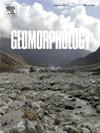利用雷达数据研究撞击坑的短期侵蚀率:对其形态的影响
IF 3.1
2区 地球科学
Q2 GEOGRAPHY, PHYSICAL
引用次数: 0
摘要
侵蚀对研究陆地撞击坑提出了几个挑战,因为它导致了柔和的形态。侵蚀不仅抹去了陨石坑的形态,也导致了地球科学家在形态方面的分歧。印度西北部的拉姆加尔陨石坑(Ramgarh Crater)就是这样一个陨石坑的例子,关于它的类型和形态有明显的争议,因为一些研究指出,一个复杂陨石坑的外缘剥蚀,其表观直径为10公里。与此同时,简单陨石坑理论认为它的边缘到边缘的直径约为2.4公里。在这项研究中,首次使用了一种先进的雷达数据分析,称为持续散射体干涉合成孔径雷达(PSInSAR),用于定量评估2017年至2022年期间Ramgarh陨石坑的短期侵蚀速率。PSInSAR是一种基于微波的遥感方法,用于测量地表运动的速率和方向。这种方法可以对陨石坑内部和周围的侵蚀过程进行更有力的分析,并促进对其形态特征的全面了解。我们使用PSInSAR进行的研究无法在凸起的遗迹结构(被认为是简单陨石坑的边缘)中发现任何显著的侵蚀(平均速度为- 0.83 mm/yr),而其他区域,包括10公里的视直径,由于农业实践、荒地地形和活跃的河床侵蚀,具有类似的侵蚀(平均速度在- 2.02至- 6.9 mm/yr之间)。此外,多次穿越的实地观测和10公里视直径的高分辨率遥感图像的视觉解释没有产生任何有利于凸起边缘的形态学证据。基于这些发现,Ramgarh可以被归类为一个简单的陨石坑,其遗迹结构的边缘到边缘直径为2.4公里,是凸起的边缘。因此,PSInSAR的实施促进了对陨石坑形态的全面检查,并最终解决了围绕拉姆加尔陨石坑的重大争论。因此,PSInSAR技术成为解决各种地质难题的宝贵工具,特别是在行星科学领域。本文章由计算机程序翻译,如有差异,请以英文原文为准。

Short-term erosion rate of impact craters using radar data: Implications for their morphology
Erosion poses several challenges for studying terrestrial impact craters, as it results in subdued morphology. Erosion not only erases crater morphology but also leads to disagreements among geoscientists on morphological aspects. Ramgarh Crater, in the north-western India, is an example of such a crater with notable contentions pertaining to its type and morphology as a few studies point towards the denudation of the outer rim of a complex crater of 10 km apparent diameter. Meanwhile, the simple crater theory argues for a rim-to-rim diameter of ∼2.4 km. In this study, for the first time, an advanced radar data analysis, called the Persistent Scatterer Interferometric Synthetic Aperture Radar (PSInSAR), is applied to quantitatively assess the short-term erosion rate of Ramgarh Crater, for the period between 2017 and 2022. PSInSAR is a microwave based remote sensing method that measures the rate and direction of ground surface movement. This method enabled a more robust analysis of erosion processes within and around the crater and facilitated a comprehensive understanding of its morphological features. Our study using PSInSAR could not identify any significant erosion in the elevated relict structure (considered as the rim of the simple crater) (mean velocity of −0.83 mm/yr) whereas other zones, including the 10 km apparent diameter, are characterized by similar erosion (mean velocity between −2.02 to −6.9 mm/yr) because of agricultural practice, badland topography and active river bed erosion. Additionally, field observations from multiple traverses and visual interpretation of high-resolution remotely sensed images across the 10 km apparent diameter did not yield any morphological evidences favouring a raised rim. Based on these findings, Ramgarh can be classified as a simple crater with the relict structure of 2.4 km rim-to-rim diameter, being the elevated rim. Thus, the implementation of PSInSAR has facilitated a comprehensive examination of the crater's morphology and has conclusively resolved a significant debate surrounding Ramgarh Crater. As a result, the PSInSAR technique emerges as a valuable tool for resolving various geological conundrums, especially in the field of planetary science.
求助全文
通过发布文献求助,成功后即可免费获取论文全文。
去求助
来源期刊

Geomorphology
地学-地球科学综合
CiteScore
8.00
自引率
10.30%
发文量
309
审稿时长
3.4 months
期刊介绍:
Our journal''s scope includes geomorphic themes of: tectonics and regional structure; glacial processes and landforms; fluvial sequences, Quaternary environmental change and dating; fluvial processes and landforms; mass movement, slopes and periglacial processes; hillslopes and soil erosion; weathering, karst and soils; aeolian processes and landforms, coastal dunes and arid environments; coastal and marine processes, estuaries and lakes; modelling, theoretical and quantitative geomorphology; DEM, GIS and remote sensing methods and applications; hazards, applied and planetary geomorphology; and volcanics.
 求助内容:
求助内容: 应助结果提醒方式:
应助结果提醒方式:


